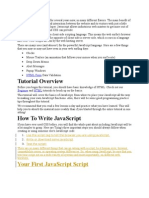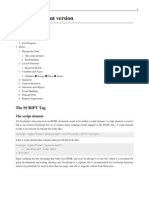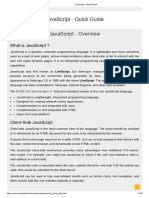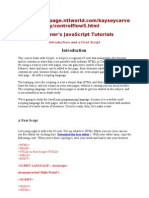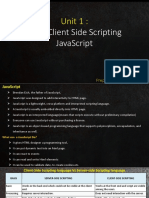Source Code For Script1.html: Listing 3-1
Uploaded by
Karnataka567Source Code For Script1.html: Listing 3-1
Uploaded by
Karnataka567home page of the browsers publisherunless youve changed the settings) is unavailable. Thats fine.
You
want the browser open, but you dont need to be connected to your ISP. If youre automatically
connected to
the Internet through a local area network in your office or school or cable modem or DSL, thats also
fine.
However, you dont need the network connection for now. Next, follow these steps to enter and
preview
your first JavaScript script:
1. Activate your text editor and create a new, blank document.
2. Type the script in the window exactly as shown in Listing 3-1.
Follow the example slowly and carefully, paying special attention to:
a. The uppercase and lowercase letters
b. The placement of single () and double () quote symbols
c. The usage of parentheses, angle brackets (< and >), and curly braces ({ and })
LISTING 3-1
Source Code for script1.html
<html>
<head>
<title>My First Script</title>
<style type=text/css>
.highlight {color: red}
</style>
<script type=text/javascript>
function showBrowserType() {
document.getElementById(readout).innerHTML =
Your browser says it is: +
<span class=highlight> +
navigator.userAgent + </span>.<hr />;
}
window.onload = showBrowserType;
</script>
</head>
<body>
<h1>Lets Script...</h1>
<hr>
<h1>Lets Script...</h1>
<hr />
<div id=readout></div>
</body>
</html>
3. Save the document with the name script1.html.
4. Switch to your browser.
5. Choose Open (or Open File on some browsers) from the File menu, and select script1.html.
(On some browsers, you have to click a Browse button to reach the File dialog box.)
22
Part I
Getting Started with JavaScript
You might also like
- Javascript/Print Version: The Script ElementNo ratings yetJavascript/Print Version: The Script Element48 pages
- Javascript For Beginners: Your Guide For Learning Javascript Programming in 24 HoursFrom EverandJavascript For Beginners: Your Guide For Learning Javascript Programming in 24 Hours3/5 (13)
- JavaScript - For Beginners - Francis John ThottungalNo ratings yetJavaScript - For Beginners - Francis John Thottungal132 pages
- Javascript Notes: Background and OverviewNo ratings yetJavascript Notes: Background and Overview41 pages
- The Difference Between HTML, CSS, JavaScript and PHP Languages PDFNo ratings yetThe Difference Between HTML, CSS, JavaScript and PHP Languages PDF5 pages
- Javascript: What You Should Already KnowNo ratings yetJavascript: What You Should Already Know6 pages
- Module 8.0 - Lesson 8.1 JavaScript SyntaxNo ratings yetModule 8.0 - Lesson 8.1 JavaScript Syntax15 pages
- Introduction To Javascript: What You Should Already KnowNo ratings yetIntroduction To Javascript: What You Should Already Know54 pages
- Y/Controlflow5.Html Beginner'S Javascript Tutorials: Introduction and A First ScriptNo ratings yetY/Controlflow5.Html Beginner'S Javascript Tutorials: Introduction and A First Script40 pages
- Introduction of HTML/CSS/JS: Ruchi Agarwal Software Consultant Knoldus SoftwareNo ratings yetIntroduction of HTML/CSS/JS: Ruchi Agarwal Software Consultant Knoldus Software36 pages
- Four Programming Languages Creating a Complete Website Scraper ApplicationFrom EverandFour Programming Languages Creating a Complete Website Scraper ApplicationNo ratings yet
- JavaScript Fundamentals: JavaScript Syntax, What JavaScript is Use for in Website Development, JavaScript Variable, Strings, Popup Boxes, JavaScript Objects, Function, and Event Handlers: JavaScript Syntax, What JavaScript is Use for in Website Development, JavaScript Variable, Strings, Popup Boxes, JavaScript Objects, Function, and Event HandlersFrom EverandJavaScript Fundamentals: JavaScript Syntax, What JavaScript is Use for in Website Development, JavaScript Variable, Strings, Popup Boxes, JavaScript Objects, Function, and Event Handlers: JavaScript Syntax, What JavaScript is Use for in Website Development, JavaScript Variable, Strings, Popup Boxes, JavaScript Objects, Function, and Event HandlersNo ratings yet
- JavaScript Fundamentals: JavaScript Syntax, What JavaScript is Use for in Website Development, JavaScript Variable, Strings, Popup Boxes, JavaScript Objects, Function, and Event HandlersFrom EverandJavaScript Fundamentals: JavaScript Syntax, What JavaScript is Use for in Website Development, JavaScript Variable, Strings, Popup Boxes, JavaScript Objects, Function, and Event HandlersNo ratings yet
- HTML5,CSS3,Javascript and JQuery Mobile Programming: Beginning to End Cross-Platform App DesignFrom EverandHTML5,CSS3,Javascript and JQuery Mobile Programming: Beginning to End Cross-Platform App Design5/5 (3)
- Developing A Scripting Strategy: Dynamic HTML and PositioningNo ratings yetDeveloping A Scripting Strategy: Dynamic HTML and Positioning2 pages
- General Ledger Accounting (FI-GL) (New) : PurposeNo ratings yetGeneral Ledger Accounting (FI-GL) (New) : Purpose1 page
